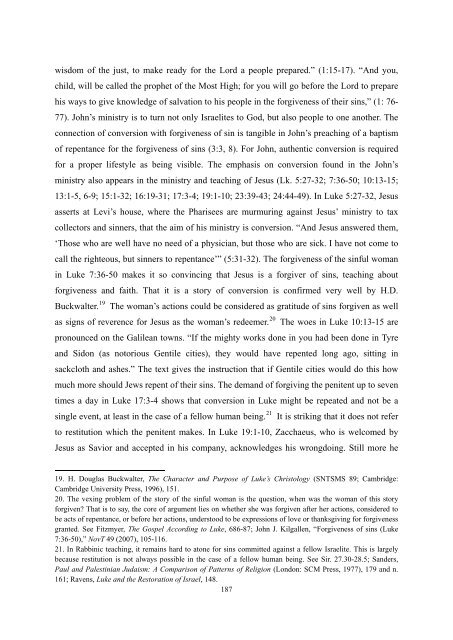the role of the lukan parables in terms of the purpose of luke's gospel
the role of the lukan parables in terms of the purpose of luke's gospel
the role of the lukan parables in terms of the purpose of luke's gospel
You also want an ePaper? Increase the reach of your titles
YUMPU automatically turns print PDFs into web optimized ePapers that Google loves.
wisdom <strong>of</strong> <strong>the</strong> just, to make ready for <strong>the</strong> Lord a people prepared.” (1:15-17). “And you,<br />
child, will be called <strong>the</strong> prophet <strong>of</strong> <strong>the</strong> Most High; for you will go before <strong>the</strong> Lord to prepare<br />
his ways to give knowledge <strong>of</strong> salvation to his people <strong>in</strong> <strong>the</strong> forgiveness <strong>of</strong> <strong>the</strong>ir s<strong>in</strong>s,” (1: 76-<br />
77). John’s m<strong>in</strong>istry is to turn not only Israelites to God, but also people to one ano<strong>the</strong>r. The<br />
connection <strong>of</strong> conversion with forgiveness <strong>of</strong> s<strong>in</strong> is tangible <strong>in</strong> John’s preach<strong>in</strong>g <strong>of</strong> a baptism<br />
<strong>of</strong> repentance for <strong>the</strong> forgiveness <strong>of</strong> s<strong>in</strong>s (3:3, 8). For John, au<strong>the</strong>ntic conversion is required<br />
for a proper lifestyle as be<strong>in</strong>g visible. The emphasis on conversion found <strong>in</strong> <strong>the</strong> John’s<br />
m<strong>in</strong>istry also appears <strong>in</strong> <strong>the</strong> m<strong>in</strong>istry and teach<strong>in</strong>g <strong>of</strong> Jesus (Lk. 5:27-32; 7:36-50; 10:13-15;<br />
13:1-5, 6-9; 15:1-32; 16:19-31; 17:3-4; 19:1-10; 23:39-43; 24:44-49). In Luke 5:27-32, Jesus<br />
asserts at Levi’s house, where <strong>the</strong> Pharisees are murmur<strong>in</strong>g aga<strong>in</strong>st Jesus’ m<strong>in</strong>istry to tax<br />
collectors and s<strong>in</strong>ners, that <strong>the</strong> aim <strong>of</strong> his m<strong>in</strong>istry is conversion. “And Jesus answered <strong>the</strong>m,<br />
‘Those who are well have no need <strong>of</strong> a physician, but those who are sick. I have not come to<br />
call <strong>the</strong> righteous, but s<strong>in</strong>ners to repentance’” (5:31-32). The forgiveness <strong>of</strong> <strong>the</strong> s<strong>in</strong>ful woman<br />
<strong>in</strong> Luke 7:36-50 makes it so conv<strong>in</strong>c<strong>in</strong>g that Jesus is a forgiver <strong>of</strong> s<strong>in</strong>s, teach<strong>in</strong>g about<br />
forgiveness and faith. That it is a story <strong>of</strong> conversion is confirmed very well by H.D.<br />
Buckwalter. 19 The woman’s actions could be considered as gratitude <strong>of</strong> s<strong>in</strong>s forgiven as well<br />
as signs <strong>of</strong> reverence for Jesus as <strong>the</strong> woman’s redeemer. 20 The woes <strong>in</strong> Luke 10:13-15 are<br />
pronounced on <strong>the</strong> Galilean towns. “If <strong>the</strong> mighty works done <strong>in</strong> you had been done <strong>in</strong> Tyre<br />
and Sidon (as notorious Gentile cities), <strong>the</strong>y would have repented long ago, sitt<strong>in</strong>g <strong>in</strong><br />
sackcloth and ashes.” The text gives <strong>the</strong> <strong>in</strong>struction that if Gentile cities would do this how<br />
much more should Jews repent <strong>of</strong> <strong>the</strong>ir s<strong>in</strong>s. The demand <strong>of</strong> forgiv<strong>in</strong>g <strong>the</strong> penitent up to seven<br />
times a day <strong>in</strong> Luke 17:3-4 shows that conversion <strong>in</strong> Luke might be repeated and not be a<br />
s<strong>in</strong>gle event, at least <strong>in</strong> <strong>the</strong> case <strong>of</strong> a fellow human be<strong>in</strong>g. 21<br />
It is strik<strong>in</strong>g that it does not refer<br />
to restitution which <strong>the</strong> penitent makes. In Luke 19:1-10, Zacchaeus, who is welcomed by<br />
Jesus as Savior and accepted <strong>in</strong> his company, acknowledges his wrongdo<strong>in</strong>g. Still more he<br />
19. H. Douglas Buckwalter, The Character and Purpose <strong>of</strong> Luke’s Christology (SNTSMS 89; Cambridge:<br />
Cambridge University Press, 1996), 151.<br />
20. The vex<strong>in</strong>g problem <strong>of</strong> <strong>the</strong> story <strong>of</strong> <strong>the</strong> s<strong>in</strong>ful woman is <strong>the</strong> question, when was <strong>the</strong> woman <strong>of</strong> this story<br />
forgiven? That is to say, <strong>the</strong> core <strong>of</strong> argument lies on whe<strong>the</strong>r she was forgiven after her actions, considered to<br />
be acts <strong>of</strong> repentance, or before her actions, understood to be expressions <strong>of</strong> love or thanksgiv<strong>in</strong>g for forgiveness<br />
granted. See Fitzmyer, The Gospel Accord<strong>in</strong>g to Luke, 686-87; John J. Kilgallen, “Forgiveness <strong>of</strong> s<strong>in</strong>s (Luke<br />
7:36-50),” NovT 49 (2007), 105-116.<br />
21. In Rabb<strong>in</strong>ic teach<strong>in</strong>g, it rema<strong>in</strong>s hard to atone for s<strong>in</strong>s committed aga<strong>in</strong>st a fellow Israelite. This is largely<br />
because restitution is not always possible <strong>in</strong> <strong>the</strong> case <strong>of</strong> a fellow human be<strong>in</strong>g. See Sir. 27.30-28.5; Sanders,<br />
Paul and Palest<strong>in</strong>ian Judaism: A Comparison <strong>of</strong> Patterns <strong>of</strong> Religion (London: SCM Press, 1977), 179 and n.<br />
161; Ravens, Luke and <strong>the</strong> Restoration <strong>of</strong> Israel, 148.<br />
187
















